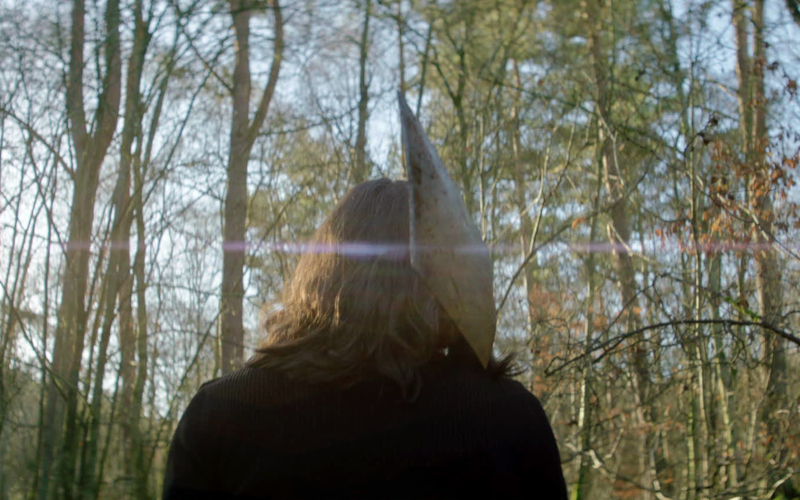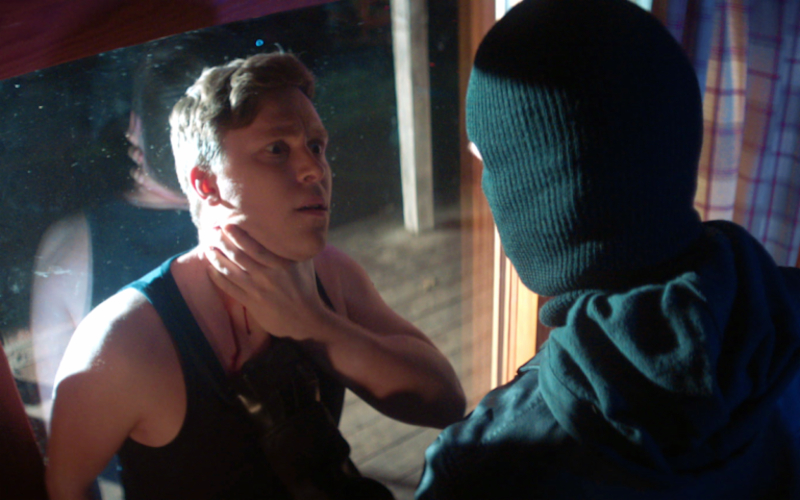Director – Alexander McGregor Birrell – 2022 – UK – Cert. 15 – 82m
***1/2
A mystery thriller writer working alone in a secluded cabin in the woods is interrupted by the arrival of a stranger – out in UK cinemas and on digital platforms from Sunday, October 8th
Developed from his 20 minute, 2019 short of the same name and starring the same two leads, Birrell’s debut feature is a curious mixture of innovation and genre cliché. Yet, enough of what’s going on here works sufficiently to hold the viewer’s attention.
Ben (Joshua Tonks, who co-wrote the screenplay with director Birrell), who isn’t named until quite some way into the film, has rented a cabin in the woods in order to write his latest novel, “if you can call it that” – he’s working in horror, thriller fiction. Tonight, he becomes engrossed in writing about his antagonist – a mysterious stranger – he suddenly becomes convinced that there is someone lurking outside the cabin. When he looks, he can see no-one. Nevertheless, his gut instinct is correct: someone is watching the cabin from the darkness.

What follows skilfully walks a knife edge between someone writing or imagining a story about being terrorised by a stranger whilst staying at a cabin in the woods and someone actually being terrorised by a stranger whilst staying at a cabin in the woods. When the stranger (Jay Clift) first turns up, he is presented as two distinct possibilities: a dangerous intruder (revealed in lightning flashes in a doorway behind Ben) and a lost person in need of help. Ben comes to the man’s aid. To complicate the dynamic, Ben is gay and is attracted to the stranger.
Although Ben is a Brit, whilst watching the film I assumed it to be American, as the cabin in the woods scenario is such a well worn device in American horror movies. Jay Clift is Canadian, so his accent reinforces this idea and the third character here, Jamie (William Tippery) – initially someone on the other end of a mobile phone who doesn’t put in a physical appearance until quite some way in, in flashback – is a UK-based Canadian, lending the idea further credence.
However, there’s no sense of the woods having a specific, geographic location; the place feels more like a generic woods you might find in an American horror movie. That’s fine as far as it goes, but an idea that the place was somewhere a bit more specific – the general area, or a nearby town, wither factual or fictional – would have anchored the piece rather better.

That said, Birrell is good at both casting and getting effective performances out of his actors (in this critic’s opinion, casting the correct actors for roles is about 80% of the work). Joshua Tonks convinces as the writer, plagued with self-doubt about the value (if any) of his work and constantly concerned that he might be lapsing into tried, tested and worn out character and narrative ideas. He’s equally believable as someone who’s had a recent tiff with his long-term partner.
Clift rises to the difficult challenge of sometimes playing the stranger as the down on his luck in trouble type and sometime playing him as a dangerous threat. Because of the way the screenplay is constructed, with the conflict between the twin realities of the writer writing a story / a man is menaced by a stranger constantly going back and forth, he proves a real asset and helps make the film’s central conceit work.
The part of initially absent boyfriend Jamie, though undeniably a smaller part – and one which has been added in during the process of expanding the original short into a feature – is well performed by William Tippery. Which doesn’t do the overall film any harm.

Some of the horror tropes seem a bit obvious – why, for instance, does Ben draw blood catching his fingers in the typewriter keys early on – as do movie general movie tropes – Ben shooting things with an old, home movies film camera – and specific romantic / gay tropes – the sexual attraction of the dangerous stranger. But just when you’re ready to pigeonhole the film, it goes into unfamiliar territory. For instance, Ben and the stranger, who’s read the manuscript, talk about the story and what the stranger would do to Ben – talked through with props, for instance the stranger tying Ben to a chair with Ben’s full agreement. Or having Ben watch the stranger looking inside the boot of his broken-down car from an angle where Ben – and we – can’t see its contents. Or even something as simple as making the stranger a hunter with a rifle.
Birrell wisely keeps the running time to just over 80 minutes; even if you sometimes wonder if he’s stretching the plot a little thin, he just about gets away without outstaying his welcome. This is consideraby more successful than the many, many shorts that have been turned into features over the years, most of which should probably have stayed as shorts – although there are other exceptions, among them Brian And Charles (Jim Archer, 2022), Junk Head (Takahide Hori, 2021) and Piggy (Carlota Pereda, 2022). The result is an effective little first feature which make you want to see what its director Birrell – and, for that matter, co-screenwriter and star Tonks – do next.
The Latent Image is out in cinemas and digital platforms in the UK on Sunday, October 8th.
Trailer:
